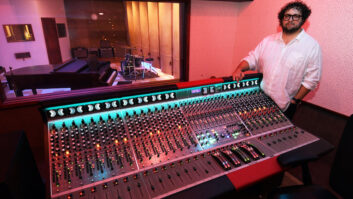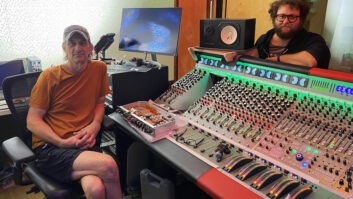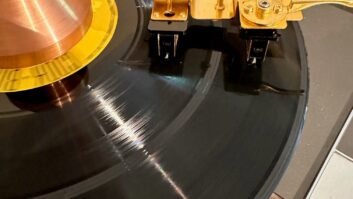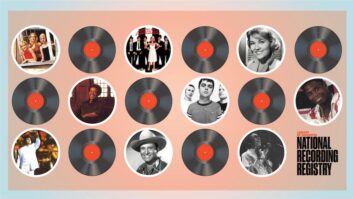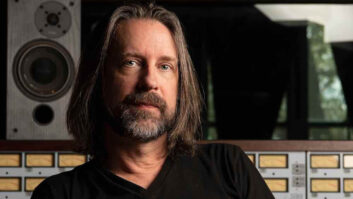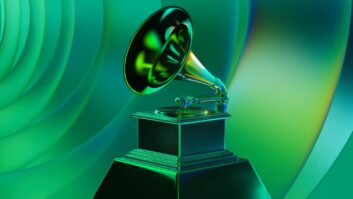Long Island-based Glen Kolotkin is hardly a household name in the recording business, but over the course of more than three decades as an engineer and occasional producer he’s worked on scores of fine albums in many different genres. Just a partial list of his engineering credits includes such artists as Moby Grape, Janis Joplin, Barbra Streisand, Santana, Captain Beefheart, Dr. Hook & the Medicine Show, Eric Anderson, Gladys Knight & The Pips, Jimi Hendrix, Joan Jett, Lionel Hampton, Paul Winter, Pete Seeger, Sonny Rollins, Taj Mahal, Vernon Reid and the Lovin’ Spoonful. Acts he’s produced or co-produced include the Electric Flag, the original stable of Beserkley Records bands (Greg Kihn, Earth Quake, Jonathan Richman and The Rubinoos), The Ramones, Duke Jupiter, cellist Eugene Friesen, The Stompers and Fairchild. (You can find fairly complete credit listings for Kolotkin and hundreds of other engineers on the All Music Guide’s site on the Web at www.allmusic.com.)
Kolotkin was born in Philadelphia but was raised mostly on Long Island. He was a staff engineer for Columbia Studios in New York beginning in the late ’60s, later moving to Columbia facilities in Los Angeles and San Francisco before becoming an independent in the mid-’70s. He moved back to New York in the late ’70s and has been active in recording there ever since. Kolotkin’s most recent engineering triumph was working on three tracks on Santana’s google-Platinum Supernatural album.
I caught up with Kolotkin shortly after Supernatural’s triumph at this year’s Grammy Awards.
What was happening musically in Long Island when you were 10?Doo-wop. In fact, some friends of mine and I had our own group. And this is how I first got into recording. our group had never heard ourselves, so I bought a 78 disc-cutting machine. Tape recorders were very expensive in those days. So we started to record the group and that’s where it started for me. When groups in high school found out I knew how to do this, they all wanted to record, so they’d come over to my house and we’d record them.
Were you technically inclined? Were you a ham radio guy?
Yeah, I was always interested in electronics, ham radios. But this was more interesting. We needed two microphones, one for the lead singer and one for the backgrounds. I got my first 2-channel mixer around that time. I think I got it at Lafayette Electronics or some place like that.
Lafayette was sort of the Radio Shack of its day?
Exactly. At this point, I didn’t really think of recording as a career. But then it sort of gradually became my work. I was in the Army and they sent me to radio school, and then they put me in charge of a radio station in Germany. Then, when I got out of the service, my uncle asked me what I wanted to do and I said, “I’d like to make records.” So he suggested I call some recording studios, and I did. I got out the Manhattan Yellow Pages and the first studio listed was A-1 Sound Studios, and I called up Herb Abramson over there, and believe it or not he gave me my first job in 1965. Nice and easy. I assume that’s the Herb Abramson of Atlantic Records fame?
Right. A-1 used to be Atlantic Studios, and when Herb broke up with Ahmet Ertegun, Herb got the studio and Ahmet got the record company. It was a small 4-track studio on 56th Street. A record Herb did around that time was “High Heeled Sneakers,” and Tommy Tucker was hanging around the studio, along with various other groups coming through there. Herb couldn’t do all the work, so I started doing sessions, with his training of course.
So was this was the classic three three-hour session blocks regimen?
Yes. Most of the groups we were cutting were small groups and it wasn’t through the union. I remember we had the Four Tops come in. They had come from Detroit and needed to do some overdubs, so we worked on that. In fact, that was the first session I did.
After that 4-track studio I went to a 2-track studio, Nola Penthouse Studio, in the Steinway Building, where we were doing big jazz sessions. Tom Nola used to record Jerry Mulligan and Ahmed Jamal, all these jazz players. Tom Nola wasn’t interested in doing rock ‘n’ roll, so I would do that work. We’d record the band, put the tape on again and copy that and add the vocals. Then we’d master it there; they had Scully lathes in the back.
After Nola’s, I answered a blind ad in the New York Times: “Major record company needs experienced engineers.” I answered that and I got a job in the remixing department of Columbia Studios. At that time, all the Columbia acts were already working with people they’d been with at the studios, so they started booking me with outside clients. So I ended up doing a lot of stuff for other labels, but at Columbia Studios. Like I worked with Melanie for Buddah Records.
One day they booked me with an artist and they didn’t tell me who it was. They gave me the setup but not the name. They said they didn’t even know who it was, but it was someone who needed some mixing done. So when the time came, in walks Jimi Hendrix with an armload of tapes! He’d been trying to mix the album that became Electric Ladyland for the longest time and he wasn’t happy, so I was the last stop. So we worked on that for about two weeks and we got along really well. In fact, he asked me if I wanted to leave Columbia and join him, but I was happy there and decided to stay.
Columbia was 8-track at this time?
Right, they had Ampex machines and Columbia built its own consoles at that time. It was funny, I saw one of those old consoles not too long ago and it looks like something that should be in the Smithsonian. It’s hard to believe we worked on Jimi Hendrix on that console. [Laughs] It really looked dated. Although at least this one had sliding faders. Some of the other ones there still had rotary faders. But I remember there was a Pultec on each channel for EQ and LA-2A’s, so they were pretty good.
The first record where I see your name listed as producer is Electric Flag. How did that come about?
I was working on it and I happened to get the credit. To be honest, I didn’t do anything different than I had been doing, but I got the credit for it. That was in New York, too. What a great band that was. I love that record. I had done some remixing on Super Session [featuring EF’s Mike Bloomfield, Al Kooper and Steve Stills], but I didn’t get credit on it. Later I worked with Al Kooper a bit; I did I Stand Alone.
Why did you leave New York and move to Los Angeles?
It just seemed like time to leave. I wanted to get out of the cold. The studio manager from Columbia’s L.A. studio, on Sunset Boulevard, happened to be in town and I casually asked him if they had any openings there, and to my surprise he said, “Yeah, come on out!” So I moved and I liked it a lot. They had the same custom console that they had in New York. And I was doing big dates there. They booked me with another New Yorker, producer Richard Perry, and he was working with Barbra Streisand. So we did the Stoney End album. We started that album in L.A. and continued it in Las Vegas. L.A. was such a record town. There were a lot of studios there and everybody knew everybody. There were a lot of 50- and 60-piece orchestra dates. It was a great time in L.A.
But shortly after this you migrated north to San Francisco?
Clive [Davis, head of Columbia Records] wanted to open a studio in San Francisco, so he asked Roy Halee to go out there from New York, and Roy asked me to join him, and we opened up Columbia Studios in San Francisco, because there was a lot happening there. They had studios in Nashville, New York, Chicago and San Francisco. Then, eventually, they closed them one by one. L.A. was the first to close, I believe.
I see you worked with Moby Grape.
I did, but actually that was in New York, not San Francisco. I worked on Grape Jam and Wow. They were good guys. Very loud [Laughs].
You also did some work on Pearl, Janis Joplin’s final album.
That was around the time I moved to San Francisco. I think I worked on three cuts [in L.A.] with [producer] Paul Rothchild and then moved to San Francisco. She was great; really a talent. Very lonely person, I guess. We became really quite friendly.
By this time you’re getting away from the three-hour session blocks.
Oh yeah, with rock ‘n’ roll bands they’d sort of camp out! That’s the way Santana was. They’d have the studio booked constantly in San Francisco. They had some kind of a deal where after they’d sold a certain amount of records the studio time was free, so they’d just book the studio and move a refrigerator in the studio and stock it every day and we’d just record all the time. Actually, it was a pretty nice way to make a record.
I was reading in Joel Selvin’s Summer of Love book that when you were working on Santana III, you were erasing solos left and right as Carlos Santana and Neal Schon tried to top each other. on Santana III there was a song called “Toussaint L’overture” that became like a contest between Neal and Carlos. Carlos would come in and do a solo. Then Neal would come in the next day and hear it and he’d try to better it. But we only had 16 tracks so he would have to erase over his own solo. It went back and forth like that a bit. I’m convinced to this day that we erased the best solo that Neal ever recorded! He thinks he topped it, but I didn’t.
Was it difficult as an engineer to keep your nose clean, so to speak, in an atmosphere rife with recreational drug use? Well, it’s a technical job and you have to keep your wits about you. Certainly it was always around. There were long sessions. There were sessions when not a lot got done. I was working mostly at night, it seemed. I’d get out of the studio at 3:30 or 4:00 in the morning every day.
As recording moved from 8- to 16- to 24-track, did the technical demands on you increase significantly?
Not really. In some ways it made things easier, especially when we went to 24, because it was more tracks for everybody. There wasn’t anything revolutionary happening in recording. It was just more tracks.
You were with Carlos Santana during one of his most interesting periods- Caravanserai and Borboletta really had that searching, questing spirit to them and he was showing some jazz influences for the first time.
Caravanserai was a big change for him. That was a great record. He got the guru [Sri Chinmoy] around that time.
Did it change the way he worked in the studio or how you related to him?
Not really. The band broke up a little because he wanted to go in one direction and some wanted to stay in that other direction. We also did that other album around then with John McLaughlin [Love Devotion and Surrender]. We did some of that in New York, I remember. And we also did Illuminations with Alice Coltrane around that time.
Another fine, underrated album. She was a pretty interesting player-harp and keyboards.
Right, and she played this Baldwin organ-it was a home organ with a speaker in it. Everyone else was using Hammonds, but she said she had a vision one time that she should use the Baldwin, so she did.
At some point you left Columbia and became an independent.
What happened was, when Clive left Columbia in the late ’70s that was really the end of Columbia San Francisco. Within a year they closed the studio and I went independent. Columbia Studios became The Automatt, and they were quite successful for a number of years.
It came at a good time for me. I’d thought I wanted to be on my own more and I was interested in doing more producing, which I did.
You co-produced so many of the early Beserkley Records albums by Jonathan Richman, Earth Quake, Greg Kihn and The Rubinoos. How did you hook up with Beserkley’s chief and self-proclaimed “reigning looney,” Matthew Kaufman?
[Laughs] I haven’t heard that for years: Reigning looney! What happened was while I was still at Columbia [SF], he brought Earth Quake into the studio and cut some tunes, and I thought it sounded pretty good so I offered to help him get a deal for them. But Matthew said he didn’t want a deal; he wanted his own label. So he started bringing in all these groups and we’d record singles with them and then he put out the first album, Chartbusters, which was all these singles, and that was the beginning of Beserkley. After that we started doing individual albums with all the artists.
What appealed to you about Jonathan Richman?
He was just so fresh and unaffected by what was going on. He wanted to do things differently. We recorded one of his records in the echo chamber at Columbia-the entire band was in there. And one song even became a hit in England, “Egyptian Reggae.” He was funny and fun to work with; kind of refreshing. And his records were like that, too.
What was Matthew’s aesthetic like? I was a real booster of Greg Kihn’s in the late ’70s because he had these wonderful pop songs that he delivered so convincingly. But I always felt that the production of his albums was somewhat flat and that Kihn’s records needed some pop sheen to get them played on the radio. Frankly, I thought Kaufman was holding him back.
I had the same feeling. I think Matthew wanted a certain purity to the sound. He wanted to record a little like the early rock ‘n’ roll guys. But it wasn’t just Matthew. They were all fascinated by Buddy Holly and the sound of those records. They had pictures of Buddy Holly sessions. Jonathan Richman wanted to record with the old microphones, and we actually set up some of those old mics in the studio, but then we kept adding microphones until we got up to the way things were done in the present time. [Laughs] He thought we could do the whole record with one microphone because that’s how some records were done in the ’40s.
After Columbia closed, where did you record the Beserkley stuff?
We did some at Wally Heider’s, but most of what I did for Beserkley was at Columbia. one time we even flew to New York and did some recording at Kazenetz and Katz’s studio in Great Neck, New York. They were the big bubblegum producers-1910 Fruitgum Company, ohio Express. Beserkley was trying to sign this new band-the Talking Heads-and we cut a demo of “Psycho Killer.” Matthew wanted to sign them but he didn’t have enough money, and what we ended up doing was giving them the tapes and then they got their deal. Actually, I liked our version better.
At some point you moved back to New York…why?
It seemed more centrally located between Europe and the West Coast. I started working with Joan Jett shortly after that [see “Classic Tracks” on page 194], and I was hooked up with [producers] Kenny Laguna and Richie Cordell, and we did quite a bit of work together. They were interesting guys. Laguna had his own ideas from the old bubblegum days. Richie had written things like “I Think We’re Alone Now” and all those hits. And we became partners after that and we went around the world producing these acts. We went to England and recorded a band called Girlschool and another called Bronze. We went to Canada and did Doug & The Slugs. We also did The Ramones around that time also [Subterranean Jungle, 1983].
What was that like?
We did that at Kingdom Sound. That was a unique band. That was interesting because I was used to bands that played guitar solos and they didn’t really do that. [Laughs] We got a friend of theirs to play some guitar solos.
What are you thinking when you take a job producing a band like The Ramones? I mean The Ramones always sound just like The Ramones…except when they worked with Phil Spector!
[Laughs] They told me stories about Phil. They were afraid of him! It’s hard to say what I was thinking. With any group you work with, you’re trying to bring out the best in them and hopefully bring something to it that they wouldn’t themselves. With a band like The Ramones, there isn’t much beyond the basic tracks-that’s what they do-so it becomes a question of capturing their energy and listening for strong performances. When you go hear those guys it’s like hearing the basic tracks and vocals. [Laughs] During this period when you were working with all these rock ‘n’ rollers were you also doing other kinds of music?
I was always doing a little jazz, it seems. When I was at Columbia I worked with Teo Macero. We did things with Lionel Hampton. We did a live thing with Miles Davis and this strange band he had in the mid-’70s with these Indian musicians. I worked with Charlie Byrd. I’ve always loved jazz.
Is there anything that’s changed fundamentally in the way you record a group?
Things have changed in the way records are made because so much is done on computers, but I never got into that. Basically, I’m still doing it the same way I always have. I try to get it to sound the way I want in the studio and then I get it to sound that way in the control room on the tape. A lot of people today don’t have that concept. They figure everything has to change so they’re playing with computers.
I try new pieces of equipment, but I find that a lot of the old favorites still work best for me. Like the U47 from 1947 is still a great microphone. RE20s are great, and for my money they haven’t been surpassed. I’m open to change but I’m not going to do it if it’s not going to sound as good.
Digital vs. analog?
When digital first came out I thought it was the greatest because it eliminated tape hiss. But people started saying it wasn’t as warm as analog, and that was true. Then Dolby came out with SR and I thought that was fantastic and I went back to that: 24-track Dolby SR.
Where do you work primarily these days?
I’ve done a lot of work recently at Sorcerer Sound, which is a very nice studio in the Village. And there’s a new place I’ve found in Connecticut called the New England Power Station, which has a nearly identical design to the New York Power Station; you’d swear you were in the New York studio. Very nice people.
What can you tell me about your work on Santana’s Supernatural, which seemed to employ every producer and engineer in the business? of course this was a reunion for you and Carlos…
A couple of years ago my wife, Carol, called me and said, “You’ve got to turn the TV on because Santana’s on.” There was the original band being inducted into the Rock and Roll Hall of Fame. I was pointing out the different people to her: “There’s Mike Shrieve, the drummer. Boy, we go back a long time,” and so on. So my wife said, “You really seem to know these guys. Maybe you should write a letter to Carlos congratulating him.” And I did and Carlos called me back right after that and asked me if I’d help him work on his new album, which was going to be his first for Arista Records. So before I knew it I was on a plane going to San Francisco and I was working with Carlos at The Plant. It was great being out there again; Marin County is as beautiful as ever.
How many tracks did you work on?
Three of them ended up on the album, but there were another four or so that didn’t make it. Maybe they’ll turn up some day.
How had Carlos changed in the 20 years since you’d worked with him?
Well, he really became the leader of the band. When I originally worked with the band in the early ’70s, I had done two or three sessions before I even knew there was a Carlos Santana; I thought that was just the name of the band. With the original band, it felt like everyone was sort of equal, but now it’s clearly Carlos’ band; no doubt about that. But he’s always been a good guy; very dedicated to his music.
Did the success of Supernatural surprise you?
Of course. I think it surprised everyone, including Clive and Carlos! Before that, I think Santana’s biggest record was Santana III, which I did. And actually, the first tune we did on the new album [(“Da Le) Yaleo”] reminds me a bit of the kind of songs that are on Santana III. I love that sound. I knew the album had a chance because Clive Davis was involved. I feel very happy for Carlos. It was great working with him again.
What are some other projects you’ve worked on the last few years that you’re particularly proud of?
I did some work with Paul Winter for a period of time and I really like those records. We did one called Whales Alive, which was songs about whales, and whale sounds and there was poetry on it. Then we did another thing with his cello player, Eugene Friesen, called Arms Around You which is really great. Not that many people have heard it, but it’s a wonderful record. I ended up producing that with Paul and Eugene. We also did an interesting project called Earthbeat, with these Russian singers, and we toured the country-13 Russian singers and the Paul Winter Consort. I did the sound for them.
Recently I’ve done some work with this new act called Mixx, which has a very fresh-sounding singer and songwriter.
Do you find that musicians know more technically than they used to?
Probably. There are more of them who know about sampling and they make these elaborate demos at home now, some of which are pretty good. But a lot of them have forgotten some of the basic things about making great-sounding records that feel good. You can’t do that with machines. I really believe that when you record a band, you have, four, five, six musicians working together as one unit and you get this feel that’s amazing; that one person could never get. You get them all working off each other, and that’s the magic. I try to record that way whenever I can. A lot of people want to go one instrument at a time, and I’m always saying, “Let’s try it as a band first.” That’s what we did with Santana and it came out great. I said, “Carlos, let’s get the whole band in here and do it the way we used to.” I don’t know if that’s now old-fashioned, but it’s still fun.


